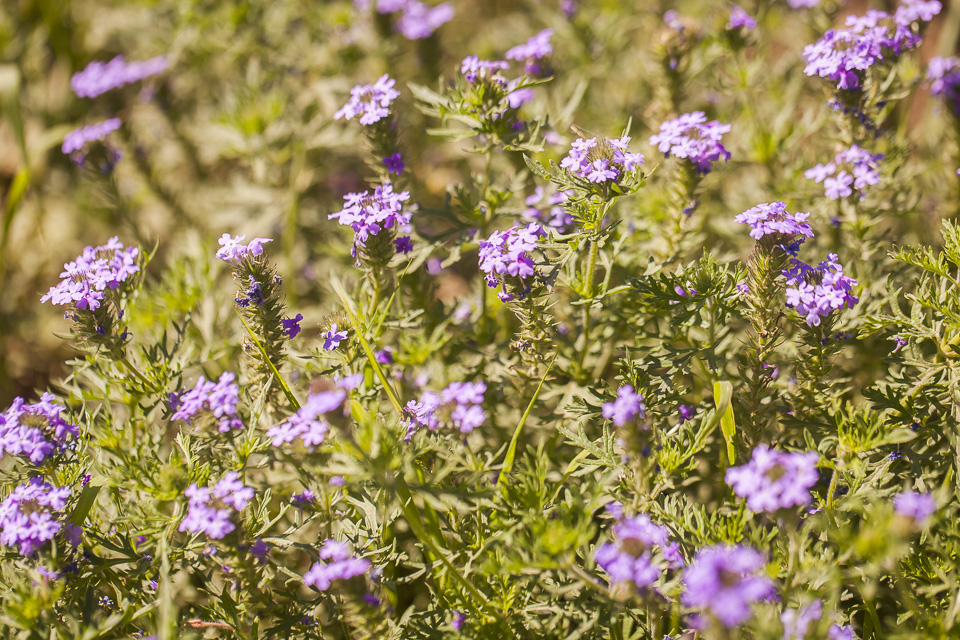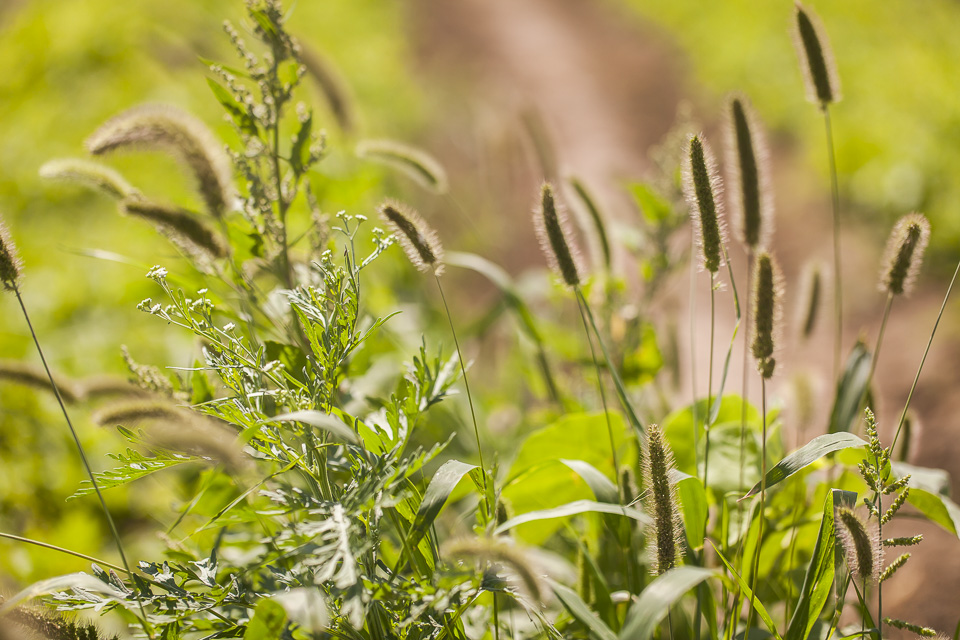
THE WORD ON WEEDS
05/18/18 — Heydon Hatcher
Hey farm friends! This week, we are covering one of the major summer farming challenges: weeds! We had a moment to sit down with Becky, our farm manager, and pick her brain on what weeds are rampant at the farm, and how to manage these pesky plants.
![]() Henbit weeds. Photo by Scott David Gordon.
Henbit weeds. Photo by Scott David Gordon.
Weed management is easier in the spring because the soil really needs to heat up for weeds to germinate. Seeds often need more warmth to germinate than to grow. That’s why we often start crops like broccoli in the greenhouse for germination and then transplant them into the fields. All that to say, about a month ago, the soil warmed up enough for the weeds to start germinating and growing. Thus, the beginnings of true craziness at the farm. With all the heat and the sun, this is not only the time when the harvest amounts really start to ramp up, but also, the weeds start flourishing. Everything starts to explode simultaneously, in a beautiful and abundant way, but also a messy and overwhelming way.
During the cooler parts of the year, we can get away with planting more crops bare ground. Different weeds have different thresholds of soil temperature for germination, so something like Henbit tends to germinate in cooler soils; whereas Johnson grass germinates when it gets way hotter. There are seasonal weeds that come through, and the cooler season weeds don’t tend to be as aggressive as the summer weeds. That’s why, as we move into summer, and the weed content starts to skyrocket, we cover more of the crops. Usually, Temo, through cultivation, can keep weeds at a reasonable and manageable level throughout the seasons.
![]() Johnson grass. Photo by Scott David Gordon.
Johnson grass. Photo by Scott David Gordon.
Mechanical Cultivation - Then we move onto mechanized weeding. We use a basket weeder which cultivates direct seeded crops or freshly transplanted crops (when they aren’t as big) on bare ground beds. This mechanism is made of rolling spring wire baskets that thoroughly weed the soil without moving soil into the crop row. These weeders are belly mounted to a tractor and go above and in between the crop rows. Temo does massive amounts of this around the farm. A lot of times, after a good rain, all the weeds will start rapidly germinate and grow, meaning Temo has to go through and cultivate everything on the entire farm to get it at a manageable state again.
In Row Cultivation - This weed management technique is done on the covered beds. The in row weeder is a mechanical tool that attaches to the back of a tractor. It goes through and cultivates the paths in between the covered crop rows. It effectively removes most of the weeds. However, when you walk through the rows, you can see that the paths are weed-free, but tons of weeks still grow in the shoulder, in between the path and the plastic. Speaking of covering plants, there are a few hot weather crops that use boatloads of water and are in the ground a very long time, like tomatoes and peppers. To save water and prevent evapotranspiration, we cover them!
![]() Amaranth. Photo by Scott David Gordon.
Amaranth. Photo by Scott David Gordon.
That's all we have for you this week. Grab your weekly veggie haul at the markets this weekend! 'Til next time!
 Henbit weeds. Photo by Scott David Gordon.
Henbit weeds. Photo by Scott David Gordon.
Weed management is easier in the spring because the soil really needs to heat up for weeds to germinate. Seeds often need more warmth to germinate than to grow. That’s why we often start crops like broccoli in the greenhouse for germination and then transplant them into the fields. All that to say, about a month ago, the soil warmed up enough for the weeds to start germinating and growing. Thus, the beginnings of true craziness at the farm. With all the heat and the sun, this is not only the time when the harvest amounts really start to ramp up, but also, the weeds start flourishing. Everything starts to explode simultaneously, in a beautiful and abundant way, but also a messy and overwhelming way.
During the cooler parts of the year, we can get away with planting more crops bare ground. Different weeds have different thresholds of soil temperature for germination, so something like Henbit tends to germinate in cooler soils; whereas Johnson grass germinates when it gets way hotter. There are seasonal weeds that come through, and the cooler season weeds don’t tend to be as aggressive as the summer weeds. That’s why, as we move into summer, and the weed content starts to skyrocket, we cover more of the crops. Usually, Temo, through cultivation, can keep weeds at a reasonable and manageable level throughout the seasons.
 Johnson grass. Photo by Scott David Gordon.
Johnson grass. Photo by Scott David Gordon.
The 4 most ubiquitous weeds at the farm:
- Henbit
- Amaranth
- Lamb’s Quarters
- Johnson Grass
The 3 main ways that we manage weeds at the farm:
Stale Seedbedding - This is when you make a bed in advance, and it either rains or you moisten the beds via sprinkler system. This stimulates all the seeds in the seed bank, or in other words, all the seeds in a bed that are hibernating in the soil. When you get that little bit of water on the soil, all the weeds will start to germinate. There is a morphological state of growth called the white thread state. Basically, the root is just one little white thread. If you disturb the weed at all during this state, you will kill it. On the other hand, when weeds get really large, even if you rip them out, there still might be some rhizomes around. Needless to say, they are harder to kill. So, if you time it right, wet your beds, go in during the white thread stage with a bed shaper, and agitate the top inch of the soil... you will kill all the weeds. Only the seeds in the top inch of the soil are going to germinate anyway. The first time around, it kills a majority of the weeds. If you do it a second time, it kills almost all the weeds that you will have in that bed. So, if you stale seedbed twice, you will virtually have a weed-free direct seedbed. This is a great soil practice, and here at the farm, we try to do it as much as possible. However, this process usually takes a couple of months, when oftentimes we only have a couple of weeks to flip the fields. So it definitely depends on timing, crop planning, weather, etc. This is a preventative soil practice, that saves loads of time later in the season. So, whenever a field is freed up that is slated to be planted, our farm manager prioritizes preparing the beds as soon as possible in the off-chance that it rains, for weed prevention and an all-around easier future harvest!Mechanical Cultivation - Then we move onto mechanized weeding. We use a basket weeder which cultivates direct seeded crops or freshly transplanted crops (when they aren’t as big) on bare ground beds. This mechanism is made of rolling spring wire baskets that thoroughly weed the soil without moving soil into the crop row. These weeders are belly mounted to a tractor and go above and in between the crop rows. Temo does massive amounts of this around the farm. A lot of times, after a good rain, all the weeds will start rapidly germinate and grow, meaning Temo has to go through and cultivate everything on the entire farm to get it at a manageable state again.
In Row Cultivation - This weed management technique is done on the covered beds. The in row weeder is a mechanical tool that attaches to the back of a tractor. It goes through and cultivates the paths in between the covered crop rows. It effectively removes most of the weeds. However, when you walk through the rows, you can see that the paths are weed-free, but tons of weeks still grow in the shoulder, in between the path and the plastic. Speaking of covering plants, there are a few hot weather crops that use boatloads of water and are in the ground a very long time, like tomatoes and peppers. To save water and prevent evapotranspiration, we cover them!
 Amaranth. Photo by Scott David Gordon.
Amaranth. Photo by Scott David Gordon.
That's all we have for you this week. Grab your weekly veggie haul at the markets this weekend! 'Til next time!






 0 ITEMS IN CART
0 ITEMS IN CART 

